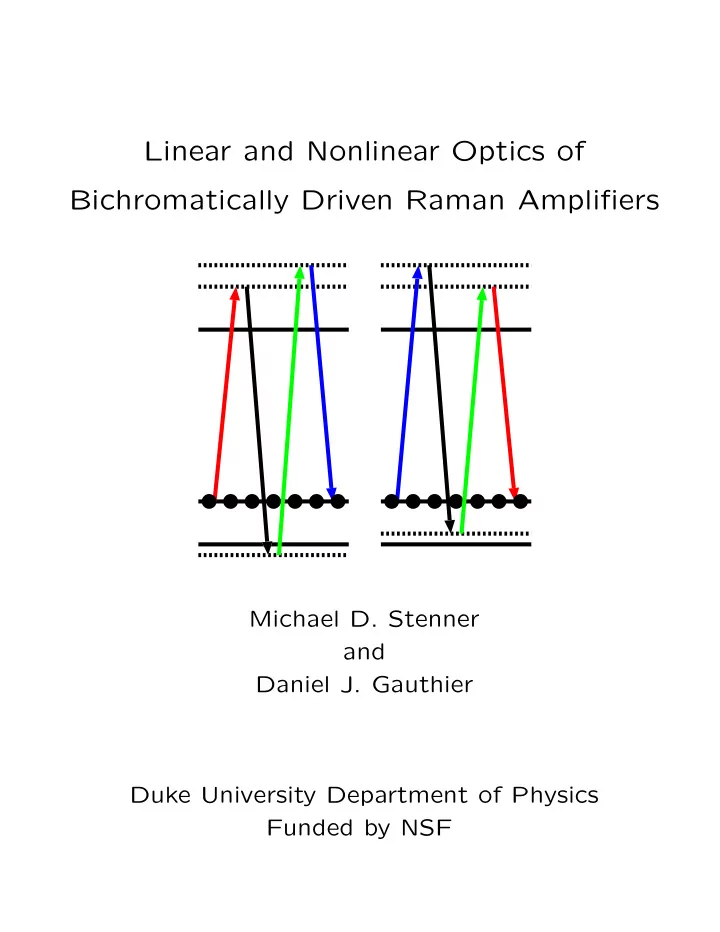

Linear and Nonlinear Optics of Bichromatically Driven Raman Amplifiers Michael D. Stenner and Daniel J. Gauthier Duke University Department of Physics Funded by NSF
Recent Results in Dispersion Tailoring 1. Slow Light ∗ 0 < v g < c 2. Fast (Superluminal) Light † vapor cell v g > c vacuum v g < 0 3. “Stopped” light ‡§ v g = 0 ∗ L. V. Hau, S. E. Harris, Z. Dutton and C. H. Behroozi, Nature 397 , 594–598 (1999). † L. J. Wang, A. Kuzmich and A. Dogariu, Nature 406 , 277–279 (2000). ‡ C. Liu, Z. Dutton, C. H. Behroozi and L. V. Hau, Nature 409 , 490–493 (2001). § D. F. Phillips, A. Fleischhauer, A. Mair, R. L. Walsworth and M. D. Lukin, Phys. Rev. Lett. 86 , 783–786 (2001). 2
New Anomalous Dispersion Technique A new method for creating anomalous dispersion was recently proposed ∗ and implemented. † anomalous absorption coefficient ( α ) dispersion refractive index (n-1) 0 -4 -2 0 2 4 frequency We are interested in studying this system in the high gain limit. ∗ A. M. Steinberg and R. Y. Chiao, Phys. Rev. A 49 , 2071–2075 (1994). † L. J. Wang, A. Kuzmich and A. Dogariu, Nature 406 , 277–279 (2000). 3
Creation of Bichromatic Raman Gain ω 2 39 K vapor cell ω 1 ω 1 ω 2 ω 1 ω 2 L. J. Wang, A. Kuzmich and A. Dogariu, Nature 406 , 277–279 (2000). (Wang et al. used red-detuned Raman pumps in cesium.) 4
Wang et al. ’s Interpretation of this New Technique M M χ ( ω ) = ( ω − ω 1 ) + iγ + ( ω − ω 2 ) + iγ 0 0 absorption coefficient ( α ) refractive index (n-1) -4 -2 0 2 4 -4 -2 0 2 4 0 -4 -2 0 2 4 frequency However, this is only part of the picture. This is not valid for high gain! 5
Another Process Contributing to the Susceptibility: Four-Wave Mixing We have discovered that in the high gain limit, a new process becomes important. 39 K vapor cell ∆ω ω 2 ω 1 ω 1 ω 2 ω p ω p ∆ω ω p ∆ω This process was not important in the experiment of Wang et al. 6
Spatial Evolution of New Frequencies low gain original intensity (arb units) frequency new high gain frequency gz I( ) I( ) ω ω ω probe ω ω probe ω 7
Our High Gain Experiment ∆ω ω 2 ω 1 39 K vapor cell absorption coefficient ( α ) refractive index (n-1) 0 ω 1 ω 2 ω p α 0 L = -9.5 25 MHz frequency probe pump power ≈ 1 µ W power ≈ 25 mW spot size = 100 µ m spot size = 280 µ m pump detuning ∆ ω = 25 MHz 8
Production of Short Pulses and Pulse Advancement output intensity (arb units) single pulse input 0 200 400 600 800 time (ns) output input averaged pulse intensity (arb units) 0 200 400 600 800 time (ns) v g = − 0 . 005 c τ p = 184 ns t adv = 130 ns 9
Conclusions • Bichromatically pumped Raman amplifier is nonlinear to lowest order in probe (pulse) intensity! • This has not been considered in prior experi- ments, because it is not important in the low gain limit. • Our high gain experiments show that a “pulse” still propagates with fast v g on average, despite the creation of new frequencies. 10
Generation of New Frequencies RF spectrum of light on the detector: 0 -10 -20 I( ω ) (dB -30 -40 -50 -60 -70 0 100 200 300 400 500 frequency (MHz) 11
Recommend
More recommend